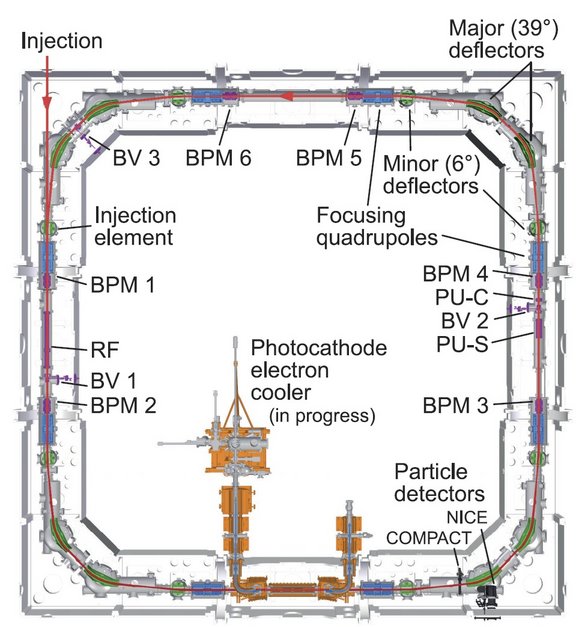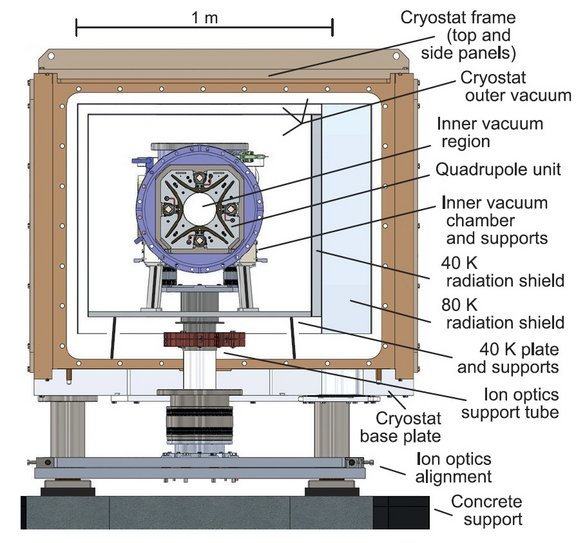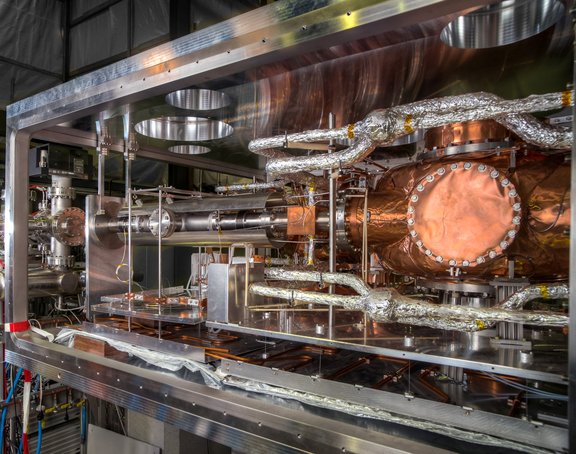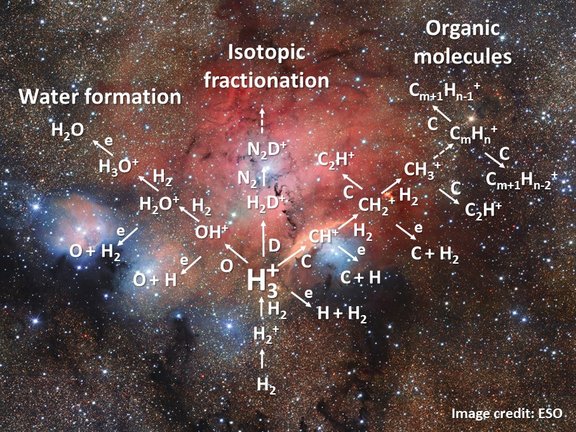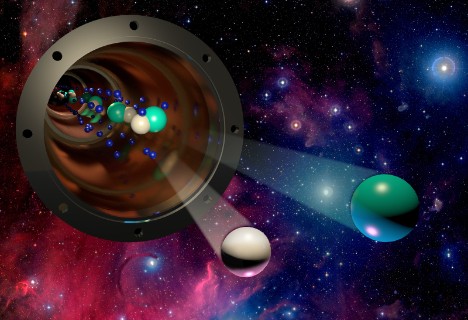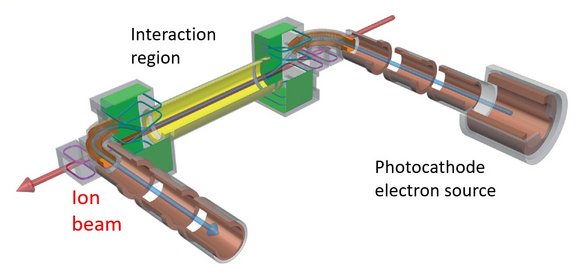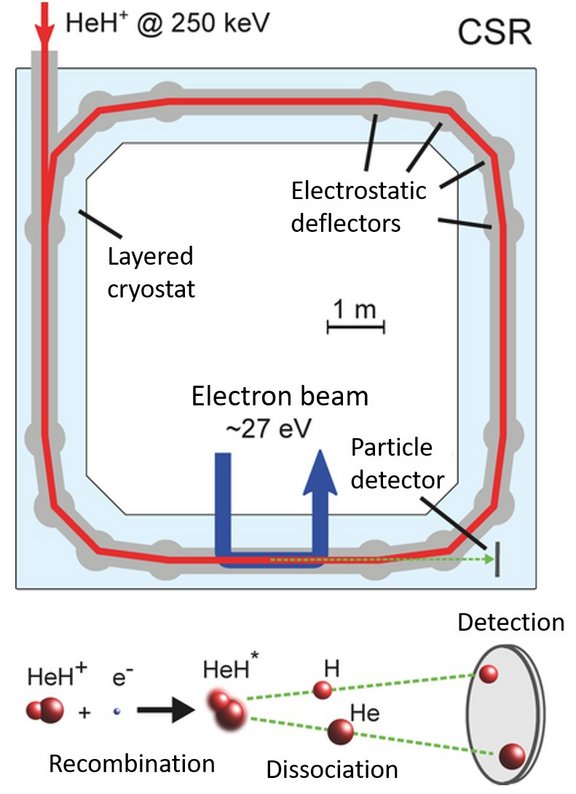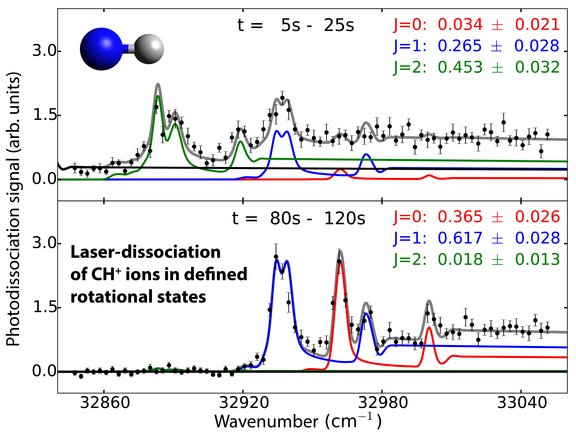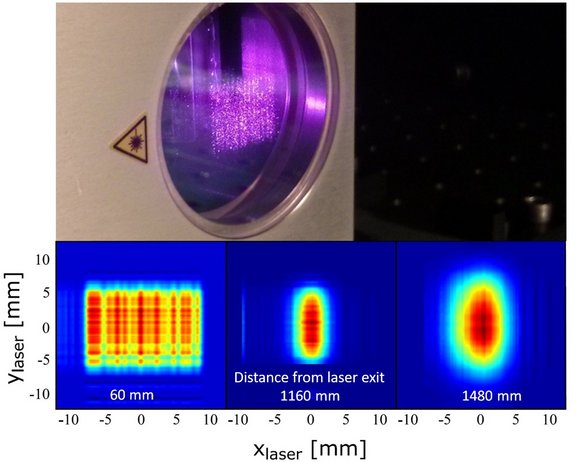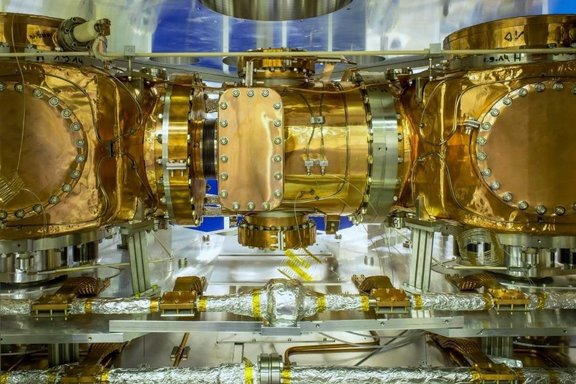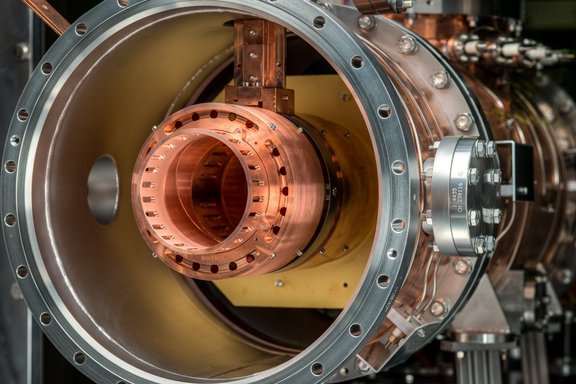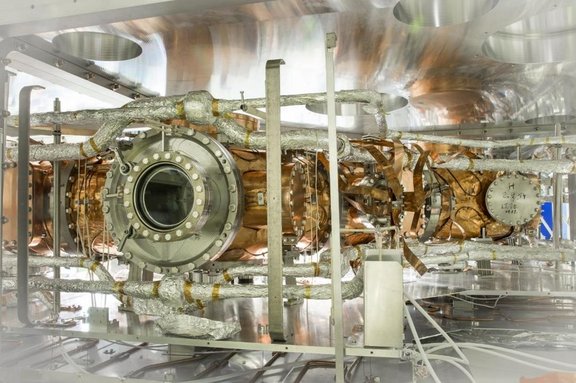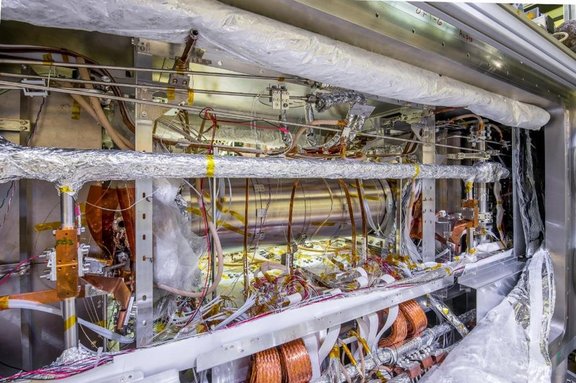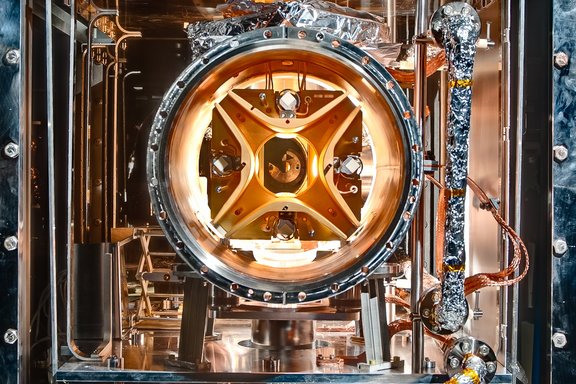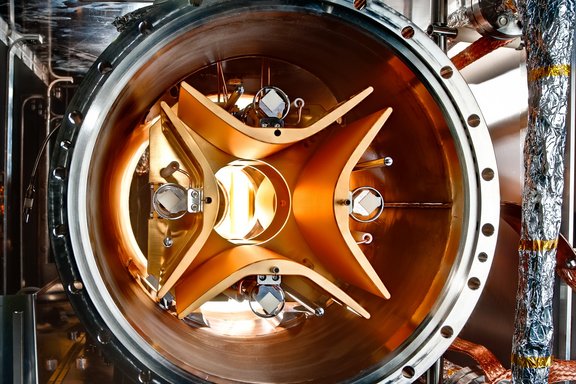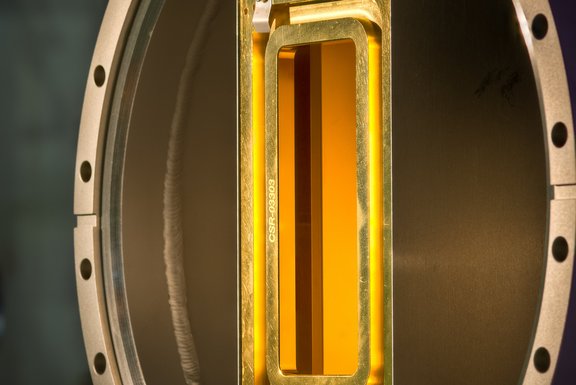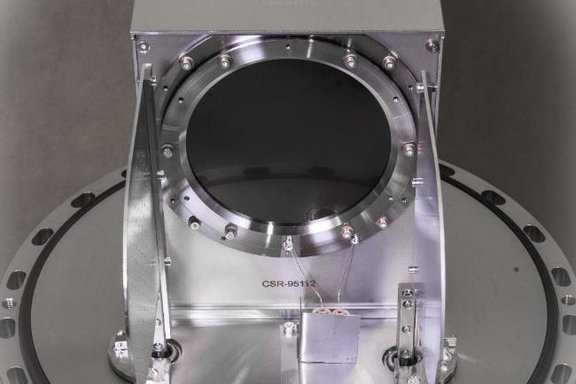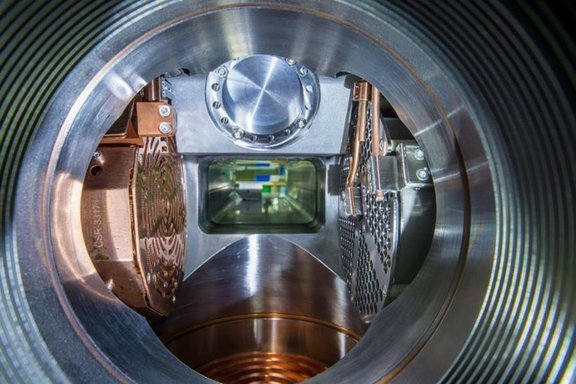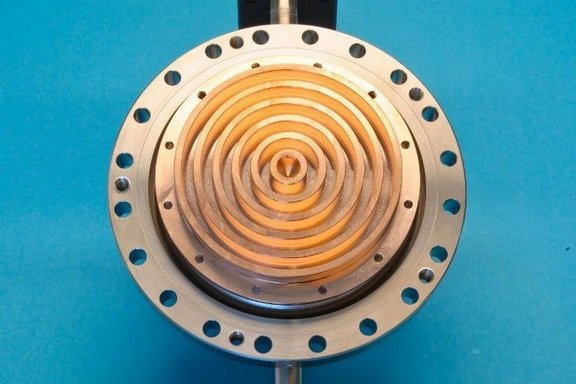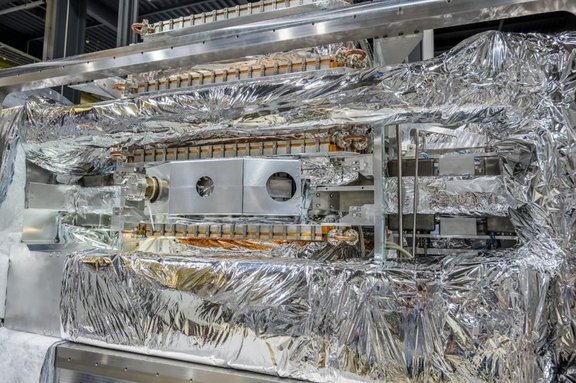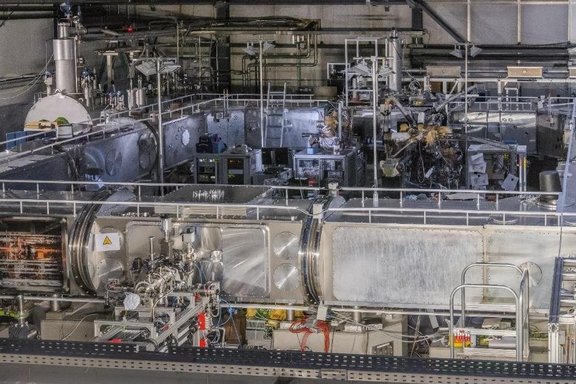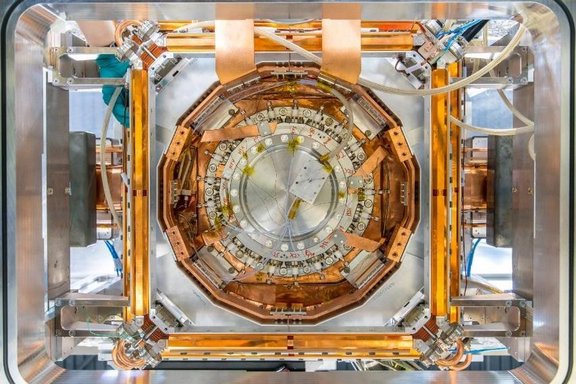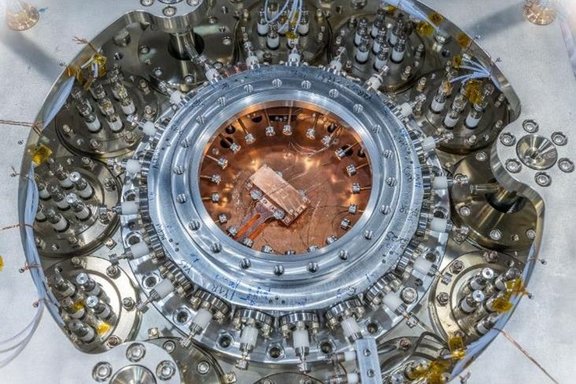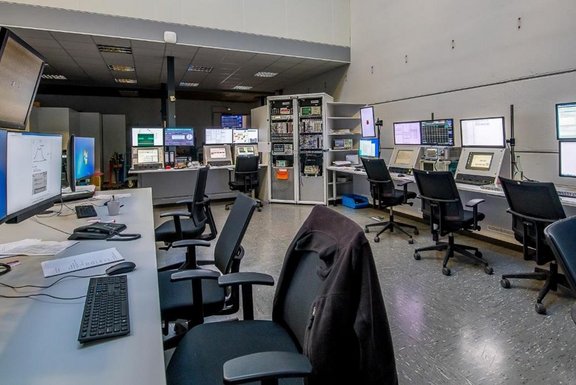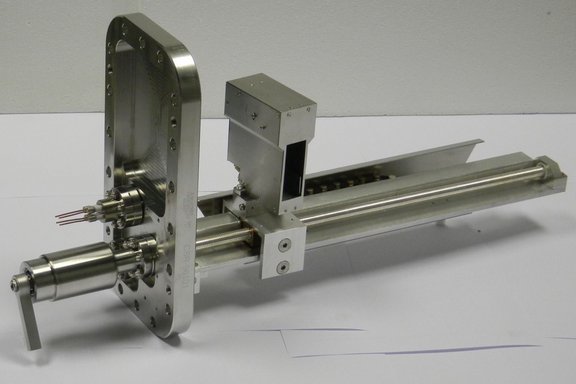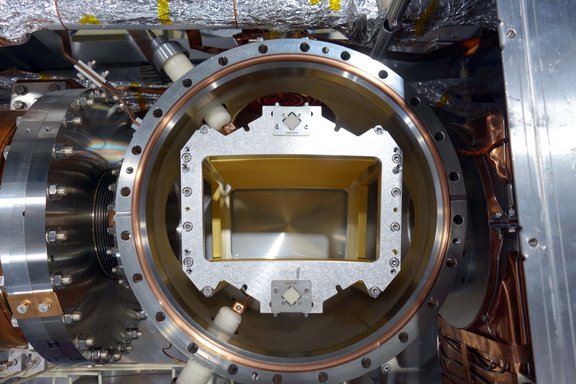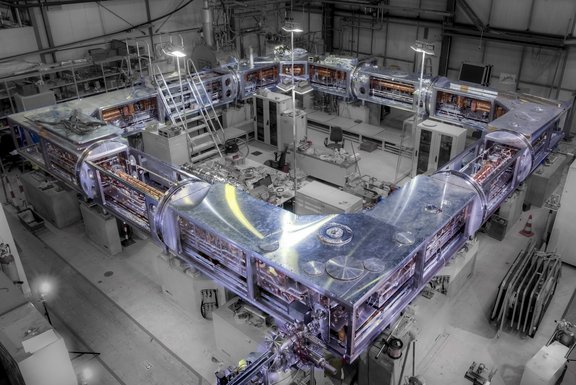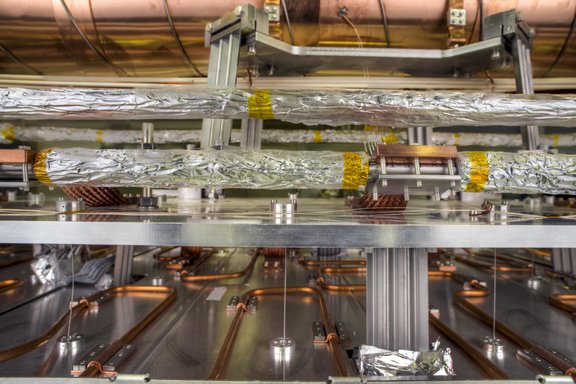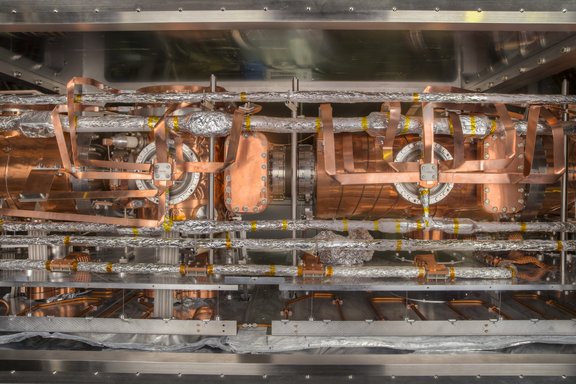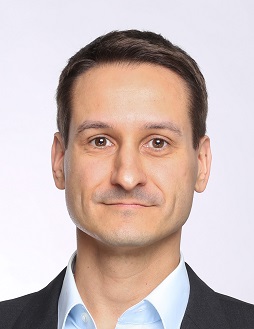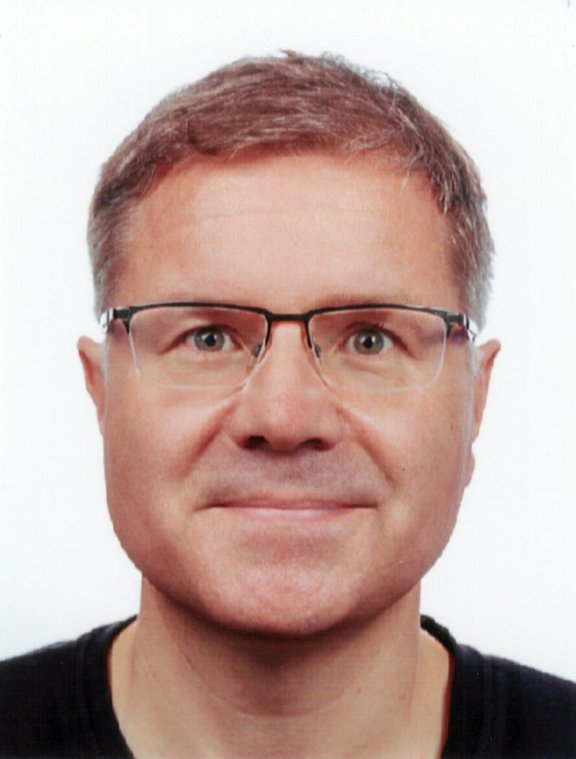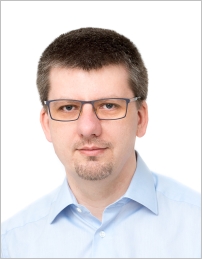The Cryogenic Storage Ring CSR

The Cryogenic Storage Ring (CSR) at the Max Planck Institute for Nuclear Physics is the largest of the new generation of electrostatic storage rings worldwide. With a circumference of 35 m and fully electrostatic ion optics, the CSR is suitable for carrying out detailed collision experiments with stored atomic and molecular ions, almost regardless of their mass. The innovative, multi-layer refrigeration concept enables experiments at chamber temperatures of -268 ⁰C (or 5 K) and at an extremely low pressure of about 10-16 atmospheres. Atomic and molecular ions can be stored in an almost interaction-free environment for many minutes up to several hours (for heavier systems). The CSR is equipped with a low-energy electron cooler, a unique merged beams setup for neutral atoms and the first fully cryogenic reaction microscope, enabling versatile experiments in the fields of molecular astrophysics and quantum dynamics of fundamental atomic and molecular reactions.
The ion-optical layout of the CSR combines the requirements of the various experimental stations with the most effective and versatile storage technology possible. The stored ions are deflected and focused at kinetic energies of up to 300 keV per elementary charge by electrostatic dipole and quadrupole deflectors. A deflection of 90 degrees is performed in each of the four corners of the CSR, divided into two 39-degree and two 6-degree deflectors. This maximizes the acceptance of the stored beam while ensuring the detection of charged and neutral fragments in the various experiments. Various diagnostic elements for beam position and intensity are distributed around the circumference of the storage ring, allowing non-destructive determination of beam characteristics. Two electrostatic platforms accelerate the ions to energies of up to 300 keV per unit charge before they are injected into the CSR.
The cryogenic concept of the CSR is linked to the requirement to achieve the best possible vacuum within the inner experimental chambers. For this purpose, there are several layers of thermal insulation in an outer cryostat structure, which serve to minimize the heat flow to the experimental chambers at a temperature of around 5 K (-268 ⁰C). The cryostat chambers are evacuated to around 10-9 atmospheres using conventional pumping technology. The entire system is cooled by a closed-loop liquefied helium system, where the re-circulated helium is used to maintain the intermediate temperature shields at 40 K and 80 K, respectively. The combination of evacuated cryostat chambers and temperature shields allows both convection and radiant heating of the inner chambers to be suppressed to a minimum.
The extreme conditions of interstellar space - with low temperatures between 10-100 K, coupled with very low particle densities - are at first glance incompatible with an active chemical network. Nevertheless, around 300 different molecular species have already been identified in interstellar space. Modern observatories such as the ALMA telescope array and the JWST space telescope are providing increasingly detailed images of interstellar objects in order to unravel the molecular composition of our universe.
The key to interstellar chemistry in the gas phase are processes initiated by charged molecular ions. These processes can only be replicated in the laboratory with great effort because the low temperatures ─ coupled with extreme vacuum ─ are difficult to reproduce. Added to this is the difficulty that the generation of charged ions usually takes place at very high temperatures, and thus produces molecular ions in undefined internal states, while the long time scales in interstellar space ensure that most molecules are in their lowest quantum states.
Here, the CSR offers unique experimental conditions that allow interstellar molecule formation ─ and the equally important dissociation processes ─ to be simulated under true space conditions. At the CSR's neutral beam experiment, intense beams of atoms in the ground state are generated in order to superimpose them with the stored molecules and to investigate fundamental chemical reactions with cold molecular ions. At the CSR electron cooler, the important dissociative electron capture process can be investigated, which significantly influences the abundance of many molecular species in interstellar environments.
The cooling of stored ions by a guided electron beam at matched velocities is an established method for magnetic storage rings and in experiments with very high beam energy. At the CSR, however, this concept poses an enormous challenge. Due to the comparatively low beam energy and the large mass of singly charged molecular ions, an electron beam must be generated at very low energy. The CSR electron cooler is the only facility of its kind in the world operated at an electrostatic storage ring. By using the photoelectric effect, electron ensembles with low energy spread are extracted from a photocathode inside the field of a superconducting magnet by means of a focused laser.
These electrons are guided by magnetic fields, expanded adiabatically and coupled into the storage ring. There, they can be slowed down to laboratory energies of 1 eV using a voltage-variable drift path. This way even heavy molecular ions weighing up to 160 atomic units can be cooled and studied.
In addition to translational cooling through the Coulomb interaction, the cold electron beam also serves as a collision partner for the stored ions. Thus, the electron capture of atomic and molecular ions can be investigated using dedicated cryogenic single-particle detectors for products in various charge states or neutralized reaction products within the CSR. These processes are of fundamental importance, e.g., for molecular astrophysics and atmospheric chemistry.
Both continuous wave and pulsed laser systems are used at the CSR, which can be coupled into the CSR at various laser paths and vacuum ports. The laser lines are used on the one hand for spectroscopic diagnosis and manipulation of internal molecular excitations, and on the other hand for studying slow cooling processes for a whole range of molecules, from simple di-atomic compounds to complex molecules and clusters.
Experiments at CSR succeeded in tracking the cooling behavior of di-atomic molecular ions at the level of individual quantum states and demonstrating that infrared-active molecular ions cool down to the lowest rotational states within a few minutes of storage. The molecules are then ─ assuming sufficiently long storage times of minutes to hours ─ in the same individual quantum states that are also occupied in cold partially ionized plasmas such as the interstellar medium.
Apart from spectroscopic experiments and the diagnosis of excited states, lasers are also used at the CSR to neutralize negative ion beams. This technique is employed to study metastable states of negative atomic ions or the cooling behavior of negatively charged clusters. Furthermore, laser neutralization with a strong continuous laser array is used to generate strong, fast atomic beams. This technique has so far been succesfully implemented exclusively at the CSR, as the only storage ring worldwiede to feature experiments with velocity-matched ground term atomic beams to study ion-neutral reactions inside the storage ring.
The latest addition to the experimental setups at the CSR is the world's first cryogenic reaction microscope. This experiment enables the kinematically complete analysis of atomic and molecular collisions. More information on the website of the department of Th. Pfeifer.
We regularly supervise Bachelor's, Master's and PhD theses in our group. If you are interested, please contact one of the group leaders by e-mail.
Dr. Florian Grussie
(CSR technology and experimental facilities)
PD Dr. Holger Kreckel
(Molecular astrophysics, ion-neutral reactions, laser expriments)
Dr. Oldrich Novotny
(Molecular astrophysics, electron cooling and electron collisions)
► Open master and bachelor theses
31Characterization of a simple gas expansion ion source for intense pulses of subthermal molecular ions
L. Berger, F. Grussie, F. Nüßlein, O. Novotný, A. Znotins, J. Fréreux, X. Urbain, and H. Kreckel
Review of Scientific Instruments 96, 013301 (2025)
30Autodetachment of Diatomic Carbon Anions from Long-Lived High-Rotation Quartet States
V. C. Schmidt, R. Čurík, M. Ončák, K. Blaum, S. George, J. Göck, M. Grieser, F. Grussie, R. von Hahn, C. Krantz, H. Kreckel, O. Novotný, K. Spruck, and A. Wolf
Physical Review Letters 133, 183001 (2024)
29Unimolecular processes in diatomic carbon anions at high rotational excitation
V. C. Schmidt, R. Curík, M. Oncák, K. Blaum, S. George, J. Göck, M. Grieser, F. Grussie, R. von Hahn, C. Krantz, H. Kreckel, O. Novotný, K. Spruck, and A. Wolf
Physical Review A 110, 042828 (2024)
28Multiple differential electron spectra from detachment in collisions of 30–300-keV anions with atoms and molecules
M. Schulz, F. Herrmann, W. Zhang, D. V. Chicharro, A. Dorn, M. Grieser, F. Grussie, H. Kreckel, O. Novotny, F. Trost, A. Wolf, T. Pfeifer, C. D. Schröter, and R. Moshammer
Physical Review A 110, 022818 (2024)
27Dissociative recombination of rotationally cold ArH+
Ábel Kálosi, M. Grieser, L. W. Isberner, H. Kreckel, Åsa Larson, D. A. Neufeld, A. E. Orel, D. Paul, D. W. Savin, S. Schippers, V. C. Schmidt, A. Wolf, M. G. Wolfire, and O. Novotný
Physical Review A 110, 022816 (2024)
26Absolute rate coefficient measurements of the reactions of vibrationally cold HD+ and H3+ ions with neutral C atoms
F. Grussie, L. Berger, M. Grieser, Ábel Kálosi, D. Müll, O. Novotný, A. Znotins, F. Dayou, X. Urbain, and H. Kreckel
Physical Review A 109, 062804 (2024)
25Merged-Beams Study of the Reaction of Cold HD+ with C Atoms Reveals a Pronounced Intramolecular Kinetic Isotope Effect
F. Grussie, L. Berger, M. Grieser, Ábel Kálosi, D. Müll, O. Novotný, A. Znotins, F. Dayou, X. Urbain, and H. Kreckel
Physical Review Letters 132, 243001 (2024)
24Dissociative Recombination of Rotationally Cold OH+ and Its Implications for the Cosmic Ray Ionization Rate in Diffuse Clouds
Ábel Kálosi, L. Gamer, M. Grieser, R. von Hahn, L. W. Isberner, J. I. Jaeger, H. Kreckel, D. A. Neufeld, D. Paul, D. W. Savin, S. Schippers, V. C. Schmidt, A. Wolf, M. G. Wolfire, and O. Novotný
The Astrophysical Journal Letters 955, L26 (2023)
23Near-thermo-neutral electron recombination of titanium oxide ions
N. Jain, Ábel Kálosi, F. Nüsslein, D. Paul, P. Wilhelm, S. G. Ard, M. Grieser, R. von Hahn, M. C. Heaven, E. Miliordos, D. Maffucci, N. S. Shuman, A. A. Viggiano, A. Wolf, and O. Novotný
The Journal of Chemical Physics 158, 144305 (2023)
22Experimental Determination of the Dissociative Recombination Rate Coefficient for Rotationally Cold CH+ and Its Implications for Diffuse Cloud Chemistry
D. Paul, M. Grieser, F. Grussie, R. von Hahn, L. W. Isberner, Ábel Kálosi, C. Krantz, H. Kreckel, D. Müll, D. A. Neufeld, D. W. Savin, S. Schippers, P. Wilhelm, A. Wolf, M. G. Wolfire, and O. Novotný
The Astrophysical Journal 939, 122 (2022)
21Isochronous mass spectrometry in an electrostatic storage ring
M. Grieser, V. C. Schmidt, K. Blaum, F. Grussie, R. von Hahn, A. Kalosi, H. Kreckel, D. Müll, O. Novotný, F. Nüsslein, and A. Wolf
Review of Scientific Instruments 93, 063302 (2022)
20An ion-atom merged beams setup at the Cryogenic Storage Ring
F. Grussie, A. P. O’Connor, M. Grieser, D. Müll, A. Znotins, X. Urbain, and H. Kreckel
Review of Scientific Instruments 93, 053305 (2022)
19Laser-probing the rotational cooling of molecular ions by electron collisions
A. Kalosi, M. Grieser, R. von Hahn, U. Hechtfischer, C. Krantz, H. Kreckel, D. Müll, D. Paul, D. W. Savin, P. Wilhelm, A. Wolf, and O. Novotny
Physical Review Letters 128, 183402 (2022)
18Metastable states of Si− observed in a cryogenic storage ring
D. Müll, F. Grussie, K. Blaum, S. George, J. Goeck, M. Grieser, R. von Hahn, Z. Harman, Á. Kálosi, C. H. Keitel, C. Krantz, C. Lyu, O. Novotny, F. Nüsslein, D. Paul, V. C. Schmidt, S. Singh, S. Kumar, X. Urbain, A Wolf, and H. Kreckel
Physical Review A 104, 032811 (2021)
17An approach for multi-color action spectroscopy of highly excited states of H+3
A. Znotins, F. Grussie, A. Wolf, X. Urbain, and H. Kreckel
Journal of Molecular Spectroscopy 378, 111476 (2021)
16Quantum-state–selective electron recombination studies suggest enhanced abundance of primordial HeH+
O. Novotný, P. Wilhelm, D. Paul, A. Kalosi, S. Saurabh, A. Becker, K. Blaum, S. George, J. Göck, M. Grieser, F. Grussie, R. von Hahn, C. Krantz, H. Kreckel, C. Meyer, P. M. Mishra, D. Müll, F. Nüsslein, D. A. Orlov, M. M. Rimmler, V. C. Schmidt, A. Shornikov, A. S. Terekhov, S. Vogel, D. Zajfman, and A. Wolf
Science 365, 676-679 (2019)
15Roadmap on photonic, electronic and atomic collision physics: II. Electron and antimatter interactions
S. Schippers, E. Sokell, F. Aumayr, H. Sadeghpour, K. Ueda, I. Bray, K. Bartschat, A. Murray, J. Tennyson, A. Dorn, M. Yamazaki, M. Takahashi, N. Mason, O. Novotný, A. Wolf, L. Sanche, M. Centurion, Y. Yamazaki, G. Laricchia, C. M Surk, J. Sullivan, G. Gribakin, D. W. Savin, Y. Ralchenko, R. Hoekstra, and G. O'Sullivan
Journal of Physics B: Atomic, Molecular and Optical Physics 52, 171002 (2019)
14Astrochemical studies at the Cryogenic Storage Ring
H. Kreckel, O. Novotný, and A. Wolf
Philosophical Transactions of the Royal Society A: Mathematical, Physical and Engineering Sciences 377, 0412 (2019)
13Transfer matrix calculation for ion optical elements using real fields
P. M. Mishra, K. Blaum, S. George, M. Grieser, and A. Wolf
Nuclear Instruments and Methods in Physics Research Section A: Accelerators, Spectrometers, Detectors and Associated Equipment 885, 124-133 (2017)
12The phase slip factor of the electrostatic cryogenic storage ring CSR
M. Grieser, R. von Hahn, S. Vogel, and A. Wolf
Journal of Physics: Conference Series 874, 012049 (2017)
11Radiative Rotational Lifetimes and State-Resolved Relative Detachment Cross Sections from Photodetachment Thermometry of Molecular Anions in a Cryogenic Storage Ring.
C. Meyer, A. Becker, K. Blaum, C. Breitenfeldt, S. George, J. Göck, M. Grieser, F. Grussie, E. A. Guerin, R. von Hahn, P. Herwig, C. Krantz, H. Kreckel, J. Lion, S. Lohmann, P. M. Mishra, O. Novotny, A. O'Connor, R. Repnow, S. Saurabh, D. Schwalm, L. Schweikhard, K. Spruck, S. Kumar, S. Vogel, and A. Wolf
Physical Review Letters 119, 023202 (2017)
10Single-particle detection of products from atomic and molecular reactions in a cryogenic ion storage ring
C. Krantz, O. Novotny, A. Becker, S. George, M. Grieser, R. von Hahn, C. Meyer, S. Schippers, K. Spruck, S. Vogel, and A. Wolf
Nuclear Instruments and Methods in Physics Research Section A: Accelerators, Spectrometers, Detectors and Associated Equipment 851, 92-102 (2017)
9The Cryogenic Storage Ring CSR
R. von Hahn, A. Becker, F. A. Berg, K. Blaum, C. Breitenfeldt, H. Fadil, F. Fellenberger, M. Froese, S. George, J. Göck, M. Grieser, F. Grussie, E. A. Guerin, O. Heber, P. Herwig, J. Karthein, C. Krantz, H. Kreckel, M. Lange, F. Laux, S. Lohmann, S. Menk, C. Meyer, P. M. Mishra, O. Novotny, A. O'Connor, D. A. Orlov, M. L. Rappaport, R. Repnow, S. Saurabh, S. Schippers, C. D. Schröter, D. Schwalm, E. S. Schweikhard, T. Sieber, A. Shornikov, K. Spruck, S. Kumar, J. H. Ullrich, X. Urbain, S. Vogel, P. Wilhelm, A. Wolf, and D. Zajfman
Review of Scientific Instruments 87, 063115 (2016)
8Photodissociation of an internally cold beam of CH+ ions in a cryogenic storage ring
A. O'Connor, A. Becker, K. Blaum, C. Breitenfeldt, S. George, J. Göck, M. Grieser, F. Grussie, E. A. Guerin, R. von Hahn, U. Hechtfischer, P. Herwig, J. Karthein, C. Krantz, H. Kreckel, S. Lohmann, C. Meyer, P. M. Mishra, C. Novotny, R. Repnow, S. Saurabh, D. Schwalm, K. Spruck, S. Kumar, S. Vogel, and A. Wolf
Physical Review Letters 116, 113002 (2016)
7MOCCA: A 4k-Pixel Molecule Camera for the Position- and Energy-Resolving Detection of Neutral Molecule Fragments at CSR
L. Gamer, D. Schulz, C. Enss, A. Fleischmann, L. Gastaldo, S. Kempf, C. Krantz, O. Novotny, D. Schwalm, and A. Wolf
Journal of Low Temperature Physics 184, 839-844 (2016)
6Generation of neutral atomic beams utilizing photodetachment by high power diode laser stacks
A. O'Connor, F. Grussie, H. Bruhns, N. de Ruette, T.P. Koenning, K A. Miller, D.W. Savin, J. Stützel, X. Urbain, and H. Kreckel
Review of Scientific Instruments 86, 113306 (2015)
5Cryogenic micro-calorimeters for mass spectrometric identification of neutral molecules and molecular fragments
O. Novotny, S. Allgeier, C. Enss, A. Fleischmann, L. Gamer, D. Hengstler, S. Kempf, C. Krantz, A. Pabinger, C. Pies, D. W. Savin, D. Schwalm, and A. Wolf
Journal of Applied Physics 118, 104503 (2015)
4An efficient, movable single-particle detector for use in cryogenic ultra-high vacuum environments
K. Spruck, A. Becker, F. Fellenberger, M. Grieser, R. von Hahn, O. Novotny, S. Schippers, S. Vogel, A. Wolf, and C. Krantz
Review of Scientific Instruments 86, 023303 (2015)
3Maximum intensity, transmission limited cold electron beams from GaAs photocathode in the eV and sub-eV kinetic energy range
A. Shornikov, D. A. Orlov, C. Krantz, A.S. Jaroshevich, and A. Wolf
Physical Review Special Topics-Accelerators and Beams 17, 042802 (2014)
2The electrostatic Cryogenic Storage Ring CSR – Mechanical concept and realization
R. von Hahn, F. A. Berg, K. Blaum, J. Crespo López-Urrutia, F. Fellenberger, M. Froese, M. Grieser, C. Krantz, K. Kühnel, M. Lange, S. Menk, F. Laux, D. A. Orlov, R. Repnow, C. D. Schröter, A. Shornikov, T. Sieber, J. H. Ullrich, A. Wolf, M. Rappaport, and D. Zajfman
Nuclear Instruments and Methods in Physics Research Section B: Beam Interactions with Materials and Atoms 269, 2871-2874 (2011)
1The Cryogenic Storage Ring and its application to molecular ion recombination physics
C. Krantz, F. A. Berg, K. Blaum, F. Fellenberger, M. W. Froese, M. Grieser, R. von Hahn, M. Lange, F. Laux, S. Menk, R. Repnow, A. Shornikov, and A. Wolf
Journal of Physics: Conference Series 300, 012010, 1-8 (2011)

